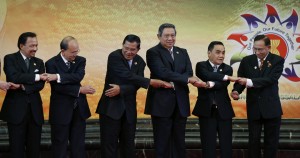Q&A: Why Southeast Asia aims for an economic union

Brunei Sultan Hassanal Bolkiah, left, and other leaders of the Association of Southeast Asian Nations join their hands for a group photo section during the 22nd Asean Summit in Bandar Seri Begawan, Brunei, Thursday, April 25, 2013. The 10 members of the Association of Southeast Asian Nations are creating an ambitious European Union-inspired economic community that will weld together diverse countries to counterbalance a rising China and an America that is increasingly assertive in Asia. AP PHOTO/VINCENT THIAN
BANDAR SERI BEGAWAN, Brunei—The 10 members of the Association of Southeast Asian Nations are creating an ambitious European Union-inspired economic community that will weld together diverse countries to counterbalance a rising China and an America that is increasingly assertive in Asia. Here are some key questions and answers on the Asean Economic Community:
Q: Southeast Asian countries already have free trade. Why is an economic community needed?
A: The AEC, as the economic community is known, is a strategy to boost the region’s economic clout. A blueprint adopted in November 2007 sets targets and timelines to fuse the 10 disparate Southeast Asian countries into a single market and production base by 2015. The plans go beyond liberalizing trade in goods. Services, investment, skilled labor and capital will also be allowed to move across borders more freely, a landmark step in economic cooperation for the region.
Q: Which countries will be part of this economic community?
A: Its members are the 10 Asean countries with a total population of 600 million people. Asean was set up in 1967 as a bulwark against communism in the Cold War era but it was only in the last two decades that attention shifted to economic integration. A wide economic gulf divides Southeast Asia’s rich and middle income economies—Malaysia, Indonesia, Singapore, Brunei, Thailand and the Philippines—and its four less developed members, communist Vietnam and Laos, Myanmar and Cambodia.
Q: What are the main things that will change in 2015 when the community comes into effect?
A: Changes will not be abrupt because the targets have been implemented gradually over the last five years.
In the area of goods, Southeast Asia has made headway with a free trade agreement in place since 2010. Its six more developed members have already eliminated tariffs on goods they trade with one another. There are a handful of sensitive items that are excluded such as rice and sugar, as well as artifacts and weapons. The other four members—Cambodia, Laos, Myanmar and Vietnam—have until 2018 to phase out import duties.
By 2015, custom clearance procedures will be streamlined through the establishment of a “single window” system. The centralized platform will link government agencies through a single Internet-based portal for permits, licenses and clearances from traders, helping to cut paper work and lower costs. Goods brought into Southeast Asian countries will not need further customs clearance when re-exported within the region.
Trade in services will be liberalized in many areas including telecommunications, air transport, health care, education, information technology, tourism, logistics services, construction and environmental services. Investors from Southeast Asia will be permitted up to 70 percent ownership in companies within these industries, which should boost competition.
There will be freer movement of the professional workforce as well as investment and capital within the region. Southeast Asian officials are also considering an Asean business travel card to further facilitate commerce within the region.
Q: Are there plans to have a common currency and parliament like in Europe?
A: No. The 10 members will maintain their economic and financial independence. There will be no central agencies such as a common central bank, parliament or court as in Europe. The AEC is based more on consensus than creating overarching institutions that take on some of the powers of member governments.
Q: How long will it take to realize the economic community’s goal of free movement of goods, services, investment and skilled labor?
A: Nearly 80 percent of measures in the economic community blueprint have been completed as of March 2013. Asean says it is on track to meet a Dec. 31, 2015, deadline. However, it says that is not the finishing line for the economic community. Southeast Asian officials say more work is required on domestic reforms, infrastructure and strengthening skills. Efforts must also be made to address trade and investment impediments, non-tariff barriers and other regulatory hindrances that have replaced tariffs as protective measures for some industries. At the same time, government corruption and unreliable courts in the region also create roadblocks to trade because they make contracts hard to enforce.
Q: How will poorer countries in the region cope with greater business and trade competition from their neighbors?
A: The economic community allows special and differential treatment for its less developed members, such as giving them longer time to liberalize. Since 2000, a program has been in place to help Asean’s four poorer nations—Cambodia, Laos, Myanmar and Vietnam—speed their development through financial and technical assistance, economic and technological cooperation, and human resource training. Asean also says they will benefit from the expansion of trade and investment within the region. Freer movement of people will also boost tourism in those countries.—Eileen Ng














